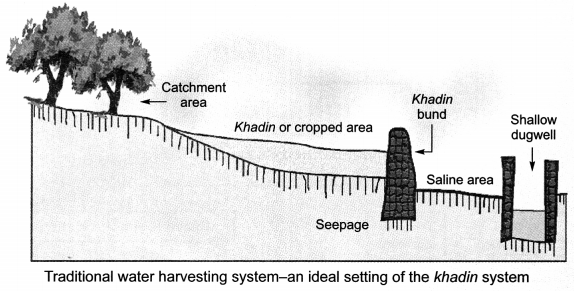 On this page, you will find Management of Natural Resources Class 10 Notes Science Chapter 16 Pdf free download. CBSE NCERT Class 10 Science Notes Chapter 16 Carbon and its Compounds will seemingly help them to revise the important concepts in less time.
On this page, you will find Management of Natural Resources Class 10 Notes Science Chapter 16 Pdf free download. CBSE NCERT Class 10 Science Notes Chapter 16 Carbon and its Compounds will seemingly help them to revise the important concepts in less time.
CBSE Class 10 Science Chapter 16 Notes Management of Natural Resources
Management of Natural Resources Class 10 Notes Understanding the Lesson
1. Natural resources: The resources provided by the nature and utilised by human beings are called natural resources. Example: Soil, air, water, forests, wildlife, coal, petroleum, etc. Management of Natural Resources is necessary for their conservation and sustainable development.
2. Efforts for Environment Protection: There are international laws and regulations; National laws and acts creating awareness and National and international organisations working towards protecting our environment.
3. Ganga Action Plan: A multi-crore project came about in 1985 to improve quality of the water in the Ganga.
4. Coliform: A group of bacteria found in human intestines. Its presence in water indicates contamination by disease-causing microorganisms.
5. Survey for Coliform Count in 1993-1994: The results of survey done in 1993-1994 for finding total coliform in terms of MPN/100 mL is:
Minimum desired level 450 MPN/100 mL; Minimum level found in Rishikesh 600-650 MPN/100 mL; Maximum level found in Kannauj 1400 MPN/100 mL.
6. Pollution of the Ganga: The Ganga runs a course of 2500 km from Gangotri in the Himalayas to Ganga Sagar in the Bay of Bengal. It is getting polluted due to the flow of garbage, excreta, untreated sewage which are dumped into it. Also, human activities like bathing, washing of clothes and immersion of ashes or unbumt corpses, chemical effluents from industries increase its pollution load. This leads to toxicity which kills fish in large sections of the river.
7. The three R’s to save the environment: Reduce, Recycle and Reuse.
8. Reduce: Use less and not to waste any resource.
9. Recycle: Segregate the waste that can be recycled and make required things by using them,
10. Reuse: Use the things again and again.
11. Reuse is better than recycling: Reusing helps to save energy, so it is better than recycling.
12. Concept of sustainable development: Encourage forms of growth and development which helps to meet current basic human needs while preserving the resources for the needs of future generations. In this way economic development is linked to environmental conservation.
13. Need to Manage Natural Resources: The human population is increasing at a tremendous rate due to improvement in health care, so the demand for all resources is increasing at an exponential rate. Since the resources are limited, the management of natural resources is necessary, so that these will last for the generations to come. This management would help in equitable distribution of resources and reducing the damage being done to the environment.
14. Biodiversity Hot Spots: Forests are biodiversity hot spots. Number of species found in an area is one of the measures of biodiversity along with the range of different life forms (bacteria, fungi, ferns, flowering plants, nematodes, insects, birds, reptiles, etc.)
15. Result of loss in biodiversity: Experiments and field studies suggest that a loss of diversity may lead to a loss of ecological stability.
16. Stakeholder: A person having interest or concern for something is called as stakeholder. The various stakeholders for the conservation of forests are:
- Local People: Those who are dependent on forests for their survival.
- Forest Department: Government who owns the land and controls resources
- Industrialists: Those who use various forests
- Wildlife enthusiasts: Those who want to conserve nature
17. Efforts of Bishnoi community in Rajasthan: Bishnoi community of Rajasthan has religiously being protecting the environment. ‘Amrita Devi Bishnoi National Award for Wildlife Conservation’ is given by the Government in the memory of Amrita Devi Bishnoi, who in 1731 AD sacrificed her life along with 363 others for the protection of‘khejri’ trees in Khejarli village near Jodhpur in Rajasthan.
18. Sustainable Management: The management of forest resources wisely and judiciously to fulfil needs of present generation as well as future generations.
19. The Chipko Andolan (‘Hug the Trees Movement’): This movement for conservation of forests originated in a remote village called Reni in Garhwal Himalayas during the early 1970s when the women of the village clasped the tree trunks thus preventing the workers of logging contractor from felling the trees.
20. People’s Participation in the Management of Forests: In 1972, the West Bengal Forest Department failed in reviving the degraded Sal forests in the south-western districts of the state by methods of surveillance and policing. Complete alienation of the people from the administration led to movements by the Naxalites and into frequent clashes between forest officials.
21. Due to efforts of forest officer A.K. Baneijee, villagers were involved in the protection of 1,272 hectares of badly degraded Sal forest. Villagers were given employment in both silviculture and harvesting operations, 25 per cent of the final harvest, and allowed fuel wood and fodder collection on payment of a nominal fee in return of such help in protection. By 1983, the previously worthless Sal forests in Arabari forest range of Midnapore district underwent a remarkable recovery and were valued ? 12.5 crores with the active and willing participation of the local community.
22. Water as a Resource
Reasons for failure to sustain water availability underground:
Loss of vegetation cover, diversion for high water demanding crops, and pollution from industrial effluents and urban wastes.
23. Dams
Advantages of Dams:
- Ensure the storage of adequate water for irrigation and generating electricity.
- Canal systems leading from these dams can transfer large amounts of water great distances. Disadvantages of Dams:
- No equitable distribution of water.
- Large number of people displaced without compensation.
- Huge amount of public money is involved without giving proper benefits.
- Loss of biological diversity and deforestation.
24. Criticisms about large dams: They lead to
- Social problems: They displace large number of peasants and tribals without adequate compensation or rehabilitation.
- Economic problems: They swallow up huge amounts of public money without the generation of proportionate benefits.
- Environmental problems: They contribute enormously to deforestation and the loss of biological diversity.
25. Narmada Bachao Andolan (‘Save the Narmada Movement’): The movement started against the raising of the height of the Sardar Sarovar Dam on the river Narmada.
26. Water Harvesting: Watershed management emphasises scientific soil and water conservation in order to increase the biomass production.
27. Aim: To develop primary resources of land and water to produce secondary resources of plants and animals for use in a manner that will not cause ecological imbalance.
28. Benefits of Watershed management:
- Increases the production and income of the watershed community
- Mitigates droughts and floods
- Increases the life of the downstream dam and reservoirs.
29. Various ancient methods of water harvesting:
- Khadins, tanks and nadis in Rajasthan
- Bundhis in Madhya Pradesh and Uttar Pradesh
- Kulhs in Himachal Pradesh
- Eris (tanks) in Tamilnadu
- Kattas in Karnataka
- Bandharas and tals in Maharashtra
- Ahars and pynes in Bihar
- Ponds in the Kandi belt of Jammu region
- Surangams in Kerala,

30. Purpose of Water Harvesting:
- To recharge the ground water beneath.
31. Advantages of water stored in the ground:
- It does not evaporate.
- Spreads out to recharge wells and provides moisture for vegetation over a wide area.
- Does not provide breeding grounds for mosquitoes like stagnant water.
- It is relatively protected from contamination by human and animal waste.
32. Coal and Petroleum
- They are generally called fossil fuels.
- They are formed from the degradation of biomass millions of years ago.
- They will be exhausted in the future no matter how carefully we use them.
- Petroleum resources will last for about forty years while coal resources will last for two hundred years.
- They contain carbon, hydrogen, nitrogen and sulphur.
- They produce carbon dioxide, water, oxides of nitrogen and oxides of sulphur on being burnt.
- Carbon monoxide is formed instead of carbon dioxide, when they are burnt in insufficient amount of oxygen.
- The oxides of sulphur and nitrogen and carbon monoxide are poisonous at high concentrations and carbon dioxide is a greenhouse gas.
- Increase in amount of carbon dioxide is leading to global warming.
33. Ways to use resources judiciously:
- Taking a bus, public transport or walking/cycling instead of a private vehicle.
- Using LED bulbs in homes instead of normal bulbs.
- Taking the stairs instead of lift.
- Wearing an extra sweater on cold days instead of burning fossil fuels for warmth.
Class 10 Science Chapter 16 Notes Important Terms
Natural Resources: The stocks of nature such as air, water, soil, forests and wildlife. Biodiversity: The diversity of life forms present on Earth.
Sustainable Management: The judicious and wise use of natural resources to fulfil needs of present generation and preserving them for needs of the future generations.
Coliform: Group of gram negative, rod shaped bacteria found in polluted water and in human intestine. Coliform Count: Measure of pollution level of a water body on the basis of presence of coliform bacteria.
Silviculture: Practice of growing trees. Helpful in replenishment of forests.
Monoculture: A culture of single type of plant or tree in an area of forest.
Deforestation: Cutting down trees.
Afforestation: Growing or planting trees.
Reforestation: Growing or planting trees in a deforested area which previously had trees and vegetation.